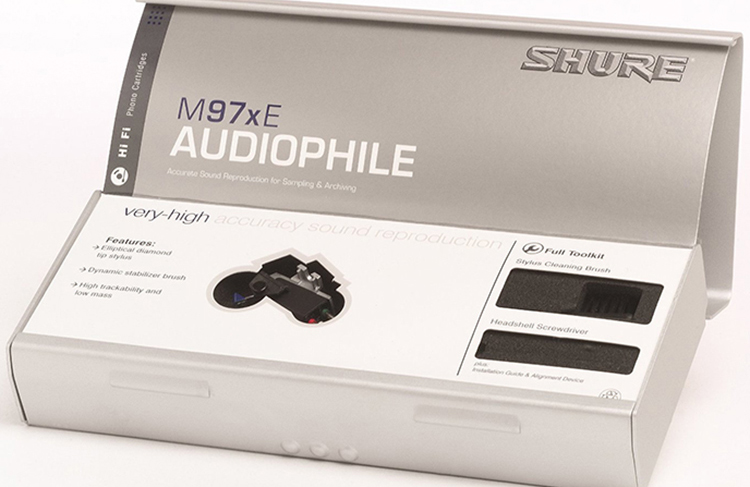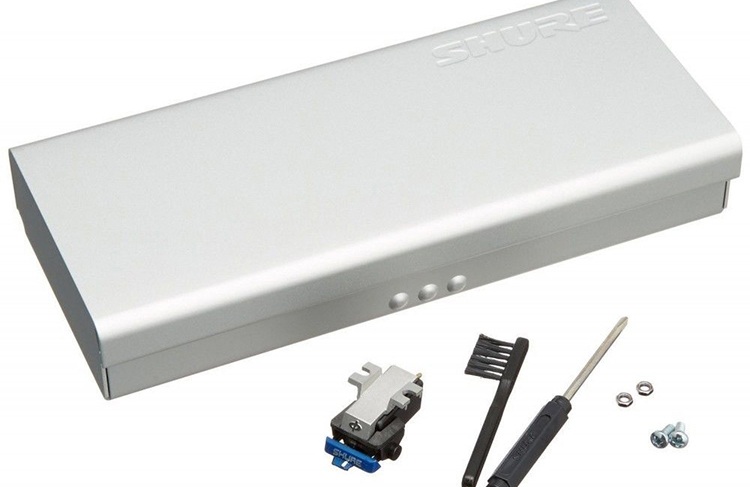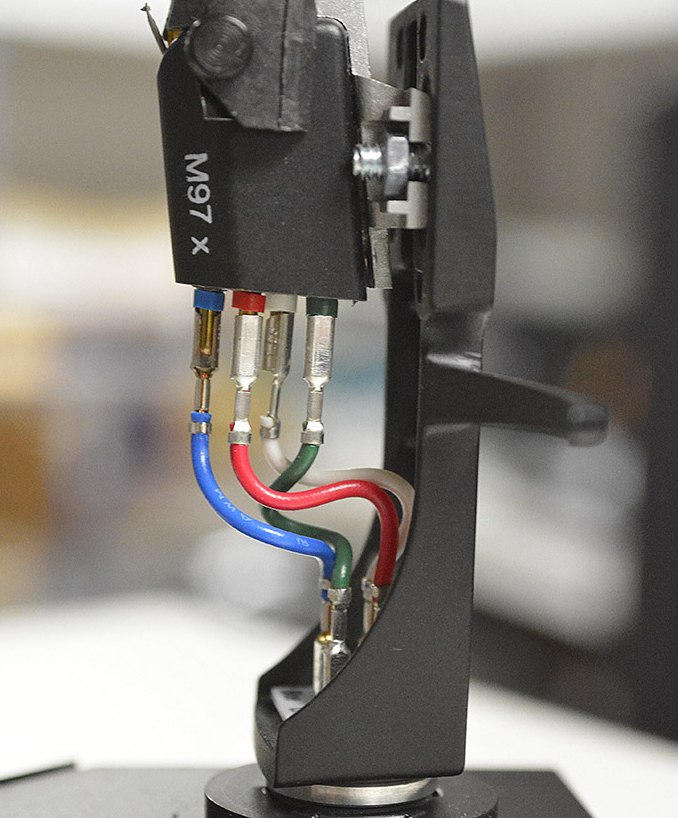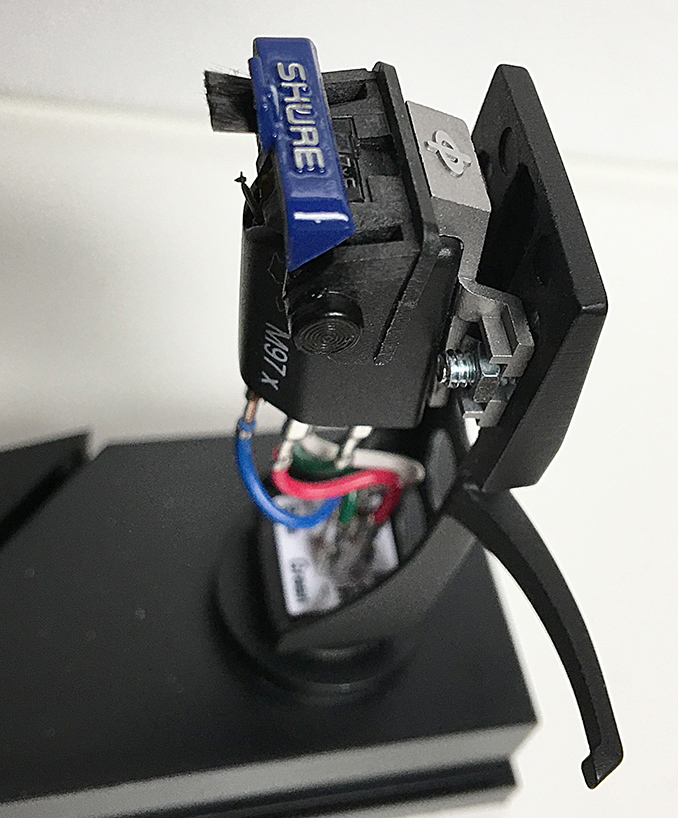Incorporating a moving magnet design, it borrows some visual cues from the classic, and vaunted, Shure V15 line of cartridges.
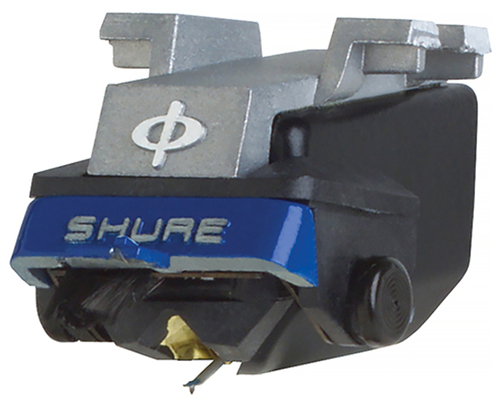
Shure M97xE Phono Cartridge
- Enjoyable overall sound. Very listenable for extended periods of time.
- Excellent midrange reproduction. Renders vocals particularly well.
- A solid and effective tracker.
- Low tracking force.
- Die-cast aluminum mounting block.
- May not have the flattest frequency response, particularly in the top end. Many listeners may find this desirable.
- Dynamic Stabilizer brush can improve playability with warped records and reduces resonances with certain tonearm combinations.
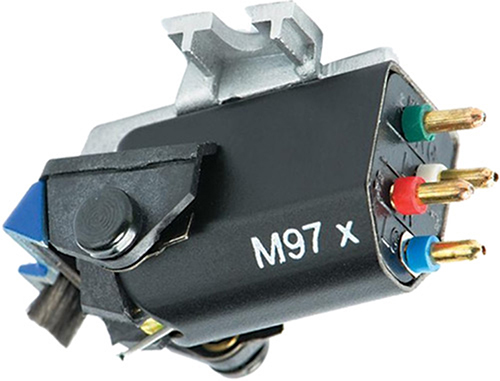
As a company, Shure Incorperated (originally called Shure Brothers) has been around since 1925 getting it’s start by selling radio parts kits in stores and, soon after, by direct mail. In the 1930s, the company ventured into microphone development and production, garnering several patents and, by the mid-1930s, they were building and supplying phono cartridges to several major turntable manufacturers. Within a short time, Shure Brothers became the largest manufacturer of phono cartridges in the US, producing upwards of 28000 cartridges per day at their peak. Among Shure’s noted developments and philosophies, in regard to phono playback, is the concept of Trackability while minimizing record wear. Specifically, Shure pioneered several developments in their cartridge designs to maintain positive stylus contact with the vinyl, under a variety of conditions, with a lower amount of tracking force to ensure record preservation.
Design:
Moving Magnet Phono Cartridge
Stylus Tip:
0.2 x 0.7 mil Elliptical Diamond Tip bonded on an aluminum cantilever
Replacement Stylus:
N97xE
Stereo Output:
4 mV @ 1 kHz
Frequency Response (Manufacturer):
20 Hz – 22 kHz
Channel Separation (Manufacturer):
25 dB @ 1kHz
Recommended Tracking Force:
1.25 grams (Brush Up), 1.75 grams (Brush Down)
Recommended Resistance Loading:
47 kOhms
Recommended Capacitance Loading:
200-300 picofarads/channel (includes tonearm wiring and phono preamp input capacitance).
Cartridge Height:
15.6 mm
Weight:
6.6 grams
MSRP:
$99.00
Company:
SECRETS Tags:
Shure, M97xE, Phono, Cartridge, Audiophile, Moving Magnet, Cartridge Reviews 2017
Another innovation for Shure was the introduction of the first stereo Moving Magnet cartridge, the M3D in 1958. Featuring an increased level of channel separation and a lower noise floor than what was standard at the time, Shure continued to develop and refine Moving Magnet technology and the concept of Trackability into the 1980s and 90s. With the introduction of the V-15V-MR in 1983, Shure created what a number of audiophiles and industry experts described as the ultimate phono cartridge of the time.
Fast forward to today, with the advent of CD’s, the “death” of vinyl, MP3s, streaming, and the “rebirth” of vinyl, Shure is still at it making phono carts, although in nowhere near the numbers and variety of it’s heyday. With benchmark products like the V-15VMR long gone, Shure’s current lineup is divided into three categories: Value, DJ and Audiophile. The single cartridge in Shure’s Audiophile line, the M97xE is what will be garnering our attention and scrutiny today.
The Shure M97xE is a moving magnet type phono cartridge. It features an elliptical shaped diamond tip mounted to a “low mass, thin-wall aluminum alloy stylus cantilever.” The mounting block for the stylus is made from die-cast aluminum and seems very rigid while still maintaining a low overall weight. The cartridge features a damped Dynamic Stabilizer brush which is said to help the M97xE successfully play warped and otherwise difficult records. The brush also has the additional, and more significant benefit, of damping low frequency tonearm resonances that one would otherwise need a dedicated tonearm fluid damper to effectively suppress. Another nice little touch is the cueing stripe marked on a small extension, attached to the Stabilizer Brush. When not in use, the stabilizer can be pushed up and safely stowed in a locked position if it is undesired for playback. The M97xE is packaged in a sturdy metal box and comes with a screwdriver, stylus cleaning brush, mounting hardware and a stylus alignment guide included.
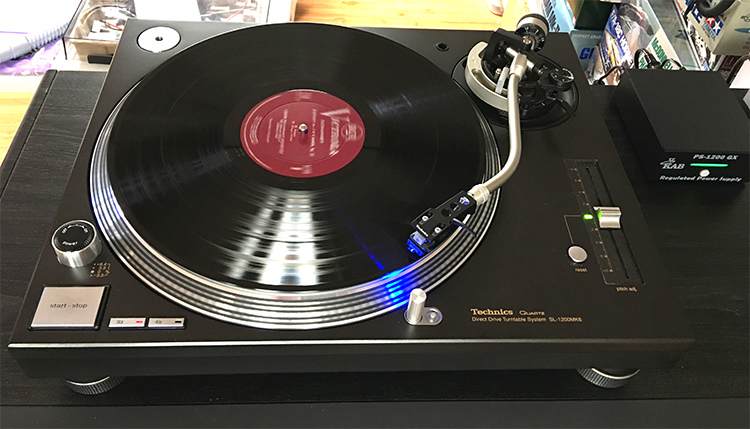
For this review, the connected components consisted of: a Technics SL1200 Mk 6 turntable with a KAB fluid dampened tonearm mod and a custom power supply, a Parasound “Zphono” phono preamp, a Bryston BP-25 line-level preamp, a Marchand XM-44 2-way active crossover, a Marchand BASSIS parametric EQ, two Class D Audio SDS-470C Power amplifiers (300 watts @ 8 ohm, 600 watts @ 4 ohm) and a Panamax M5500 power conditioner. Speakers are Bamberg Engineering Sound Labs Series 2 Monitors and a pair of sealed DIY 15-inch subwoofers. Speaker wire and interconnect cable by Blue Jeans Cable.
Secrets Sponsor
The Shure M97xE was installed in an OEM Technics SL1200 head shell and was mounted using the Technics Overhang Gauge and aligned using the alignment guide that was bundled with the cartridge. Tracking force was set using a digital tracking force scale and anti-skate was set with the aid of the anti-skate band track of the Shure “An Audio Obstacle Course” LP (TTR-101). Tracking Force was set to the optimum levels as recommended by the manufacturer, in this case 1.25 grams with the stabilizer brush stowed and 1.75 grams with the brush engaged. After some experimentation, I settled on the brush being down for listening tests as there was a minor subjective lowering in surface noise and an overall quieter (some call darker) general background, which I found desirable. The bench test section will show the measurements with the brush up in most cases as my KAB tonearm fluid damper did much of the same job as the brush. The fluid damper was removed in specific tests to highlight the effect of the brush on a typical undamped tonearm. Shure specifies that playback may show improved sound quality, under ideal conditions, with the brush stowed but I did not find its use to be detrimental at all under any circumstance.
The Shure M97xE under review is my own personal cartridge that I purchased back in February. It was about 4 months old and has seen moderate usage at the time of its testing. It physically appears to be a nicely put together unit. Nothing feels loose or unduly fragile when handled appropriately. Releasing the stabilizer brush reveals that it is not just some loosely attached appendage with a brush but, in fact, a precisely damped apparatus. Installing it in the head shell, aligning it correctly and dialing it in with the tonearm presented no undue challenges outside of the norm.
Having lived with this cartridge now for a number of months, I can easily say that bass and midrange performance are certainly its strong suits. These characteristics were immediately noticeable from the get-go and remained consistent throughout my listening. Both male and female vocals tended to have a smooth and liquid quality about them. I don’t mean that to imply that they sounded soft or lacked any presence at all. More to the point, I found that nicely recorded vocals from a well-kept piece of vinyl will have an appealing smoothness with this cartridge that will be easy to enjoy with repeated listening. At the bottom end of the spectrum, electric bass lines had a good deal of punch when called for and, in general, seemed well balanced with a variety of musical material. Kick drums, tympani and stand-up bass all fared very well with the M97xE and each were rendered with authority and a good level of detail all around.
I think where people are either going to love or hate this cartridge is going to be with regards to high frequency reproduction. The Shure seems to roll off the high end a little earlier than what might be expected. This behavior bolsters the “smooth” sounding and “fatigue-free” nature of the M97xE’s performance. This can be beneficial if, say, you have a large number bright sounding disks in your collection. I have a number of Deutsche Grammophon and Columbia Masterworks classical LPs that are, by and large, very bright recordings. The Shure makes an excellent match for these disks, calming the top end response and making these pressings much more enjoyable musical sojourns. However, if you are looking for a more balanced presentation from your cartridge, especially above 4000 Hz, the M97xE may not satisfy you. There were a few occasions where listing to the Shure left me wanting for a little more sheen from cymbals or upper end bite from an electric guitar solo. Overall though, it is an easy cartridge to live with and listen to for most of the albums I play on a regular basis. And while I don’t have any seriously warped LP’s around, I do have some with mild levels of warpage that the M97xE showed no issue with tracking faithfully.
I found the Dynamic Stabilizer Brush’s benefits to extend even to my already damped tonearm, although to a lesser degree than what will be shown on the bench tests with the tonearm damper removed completely. Beyond the stray static and dust particle removal, I found the background of the music to be a bit quieter when the brush was in use. This had the side-effect of helping some of the subtle parts of various recordings stand out more. Some posts on various vinyl forums that I’ve come across indicate some users found a perceived reduction in treble response when using the brush full time. I did not experience this in the slightest during my review, either subjectively or when I compared frequency measurement sets with the brush up versus brush down. Frequency response in both states was identical.
Some of the more memorable music selections that I experienced with the Shure M97xE:

A re-release of Otis Rush’s first album now on 180-gram vinyl, this LP sounds very lively and fun through the Shure M97xE. Rush’s vocals sounded clear and forward except on tracks like “Me” where there is additional echo added by design. And speaking of the added echo, it noticeably stood out more when the stabilizer brush was in use.
While this is not the most dimensional of recordings, the Shure does an especially good job working with what’s there. All the instruments are clearly discernable and have a modest amount of spread between each other. The bass lines have a great sounding groove to them and stand out through all the tracks. But the star is Otis and his guitar and it is well represented throughout the LP, especially on tracks like “Working Man” and “You’re Killing My Love” where it’s distinctive tone really stands out along with a decent amount of string detail. However, my favorite track on this album has to be “Reap What You Sow” which features Otis Rush at his vocally most expressive and includes standout guitar playing by himself along with Duane Allman and Jimmy Johnson who play backup guitar on the entire album. The Shure does a fine job with Rush’s vocals here, particularly in the softer passages, and the keyboards on this track show off with a good deal of body and warm tone as well.
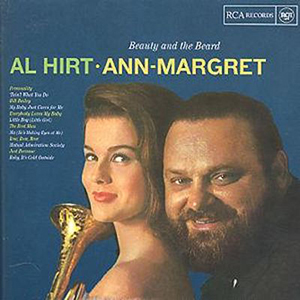
A somewhat unexpected but fun, and enjoyable, vocal combination mated to Hirt’s trademark horn solos and fills. The natural, almost conversational, quality to Hirt and Margret’s singing on “Personality” sounds full and lush through the Shure cartridge.
Al Hirt’s vocals, in particular, being softer and deeper in tone were right up this cart’s alley and it wasn’t lacking in the detail department either. Every breath and vocal inflection came through clearly for both singers. On the track “Bill Bailey,” Anne Margret’s singing starts off soft and low in the first part and soon goes to a full power belt by mid-song without exhibiting any level of breakup or compression. The Shure clearly reveals that, beyond the Vegas kitsch of the time, Ann Margret was a vocal force to be reckoned with in her prime. The M97xE also does a great job reproducing Al Hirt’s powerful trumpet playing making it very easy to listen to without a hint of grain or glare. On the track “Everybody Loves My Baby” there is a sweet-sounding clarinet solo by a guy named Pee Wee Spitelera (gotta dig that name!) that just sounds so liquid and smooth coming from the Shure that it’s sort of the unexpected cherry that tops an otherwise great and swinging song. On the, recently controversial, “Baby it’s Cold Outside” Ann Margret’s voice is clearly in the spotlight and the M97xE deftly mines every drop of character and nuance of it from the grooves. It is a truly lovely performance that puts both her, and Hirt, squarely in the room with you.

An early digital recording from 1983, this LP features well known overtures that practically everyone has heard in one form or another (particularly if you spent much of your youth watching old Warner Brothers cartoons, but I digress).
The Shure M97xE, true to its ad copy, gave me a smooth and very listenable presentation overall. There was good clarity and separation between the instruments with decent finesse when reproducing flute and triangles during some of the quieter passages. The pastoral cello intro at the beginning of the “William Tell” overture had a lovely quality to it with plenty of meat-and-bones coming through from those solo strings. On some of the more boisterous parts of “The Barber of Seville” and “William Tell,” the Shure relayed plenty of punch and impact from the tympani drums. The strings and the woodwinds sounded natural as well but I felt that they were bleeding together a little when things got loud and frenetic. I will say though that the sound of the plucked strings and the solo oboe at the beginning of “Italian Girl in Algiers” was particularly satisfying with a lovely weight and detail to the plucks and velvety smoothness to the oboe. In contrast though, I felt that the cymbals and chimes in the background of the same piece could have stood with a little more luster and sheen at the top end. Still, a very enjoyable experience to listen to with this cart.
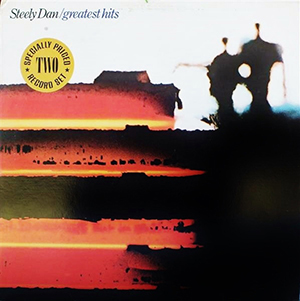
A classic “Best Of…” LP found in many a fan’s collection. A number of cherry-picked tracks showcase the group’s well-known penchant for sound quality and musicianship and it comes across admirably over these twin black platters of plastic.
Donald Fagan’s unmistakable vocals on “Kid Charlemagne” sounded just about right with enough of its nasal characteristics coming through while still sounding solid and slightly warm. Kick drum was properly punchy sounding with good heft to it and Larry Carlton’s signature guitar solo sounded excellent with a good amount of bite and detail to the sound. My only complaint is that the high-hat cymbals that play continuously through the song weren’t quite as crisp sounding as I am used to. “Reeling in the Years” sounded very good. The chorus vocals were a particular standout, being very smooth and harmonious. Elliot Randall’s Guitar solo sounded good but was maybe missing a little something in the higher notes. The bass lines on “Haitian Divorce” were tight and easy to follow along with the solid and ever-present kick drum. The talk-box guitar solo was also handled very well by the Shure with the commensurate amount of detail and edge. Like I said, the M97xE does really well with the bass and mids.
Secrets Sponsor
When all is said and done, this is a very warm and enjoyable cartridge to listen to and, for $99 bucks, gets you better than decent sound for the money. Is it perfect? Of course not. I personally would prefer it if it didn’t roll off the highs so early using recommended standard loadings. If you have a phono preamp with adjustable resistance loadings then you can tweak and tweeze the sound a bit I suppose. But, I would prefer starting with a cart that already has a fairly flat response at standard settings if that’s what I was going to do. As Shure’s most expensive current cart, the M97xE is a good starter cartridge for someone who wants to actually enjoy the “sound” of vinyl as opposed to the “fad” of vinyl. If you’ve got a recent vintage entry-level turntable, particularly if it’s one of those with a built-in USB output for digitizing your LPs, promptly ditch whatever suspect cartridge that came included and get M97xE in there “tout-suite.” Using the dedicated stabilizer brush alone will help the tonearm immensely at its job and help it perform better than it probably has any right to. This is a “gateway” drug that will eventually get you to want to explore what a bit more cash will net you in terms of performance. And while better can be had, look to spend almost three times the price of the Shure for something legitimately better. You’re not going to find a high-compliance cartridge with such a low tracking force that actually tracks well and is as gentle to your records for any kind of reasonable money. This has always been, and still is, Shure’s calling card.
With the resurgence of LP playback in the marketplace, I would like to see Shure do a deep dive into its vast well of phono knowledge and bring us a new cartridge that M97xE owners could step up to. Some of that vast research and knowledge can be seen here.
The classic V15V-MR was the de-facto standard in moving magnet design. So much so that the Library of Congress bought up the remaining stock when it was discontinued.
What do you say Shure? Is it time to dust off the old patents and bring us back a legend?
Bench test analysis by David A. Rich and Carlo Lo Raso.
Benchmarks were obtained by using a Technics SL1200 Mk 6 turntable, which has been modified and rewired by KAB Electroacoustics, as a testbed. The turntable is plugged into a Parasound ZPhono preamp, which has a simple but excellent quality 2-stage phono section. Each cartridge will be measured using test tracks from the CBS Technical Labs (STR 100) test LP and three tone intermodulation tests from the Shure V15 Type 5 Audio Obstacle Course LP (TTR 117). The output, from the phono stage, will be recorded digitally at 24-bit 48 kHz (to minimize groove wear on the test LPs) on a TASCAM HD-P2 digital recorder. Those results were analyzed on my computer using SpectraPLUS audio measurement software via the Lynx TWO B professional sound card. Unless otherwise stated, the tests were done with the stabilizer brush stowed and tonearm fluid damper in use.
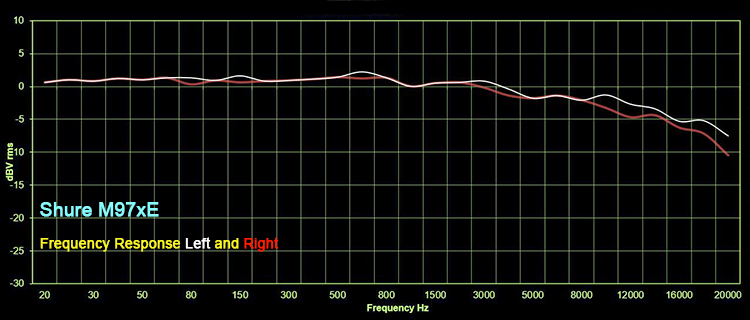
Frequency response and Channel separation.
The Shure M97xE’s measured frequency response shows that the upper end starts to gradually roll off from 4kHz on up. Left and right traces track fairly closely until about 10kHz. As the frequency gets higher, the test tone level declines on the CBS STR 100. More error in the measurement is introduced at higher frequencies which may explain some of this deviation.
Shure’s are known for very flat frequency response. We scanned reviews from the 60s to 80s, in three magazines, of similar Shure M95 and M97 cartridges and found nothing that looks like what is shown above. The answer was on the web.
In 1998, when Shure moved phono cartridge production to a new smaller factory, the typical laminated cores used in good phono cartridges were replaced by a solid core. Was that the difference? By luck John Elison, a retired mechanical engineer and audio hobbyist, posted measurements of the post-1998 Shure V15VxMR as well as a number of well-known moving coil cartridges. It was invaluable information but you will never find it hidden as a post. We only found it searching for posts on test LPs.
The same tilted down response we measured can be seen in the Elison measurements. As typical, almost all of the moving coils John Elison measured showed a pushed at the top end.
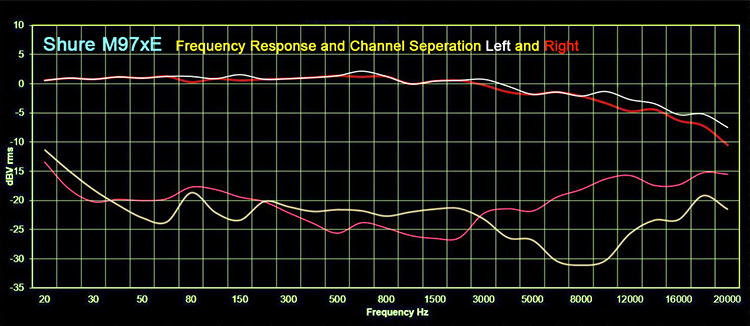
This chart shows the left channel frequency response directly compared to the right channel separation as well as the reverse condition. This is not an automated test. 29 individual tones times 4 sweeps equal 116 total measurements for this graph.
Note the imbalance above in the graph above 3000 Hz which may be a quality control issue but at $100 this is an excellent result. It is rare for the best cartridges to drop below 30dB at any frequency.
We cannot show it here but it is not just amplitude but also phase that changes with frequency in the crosstalk measurement. The high levels of inter-channel crosstalk coupled with the phase variations are often cited as reasons for the subjective preference on LPs. This will change the stereo image. Out of phase components can simulate depth. Couple this with the large amount of pleasing 2nd harmonic distortion shown below and you start to understand the CD – LP debate from an objective point of view.
It does not appear that the solid core is the issue with crosstalk performance. The John Elison measurement of the Shure V15VxMR shows 30dB separation from 100Hz – 20kHz.
At low frequencies, turntable rumble typically dominates these channel separation graphs. For this reason, chart recorder graphs typically stop at 500Hz. Using the spectrum analyzer to isolate the fundamental increased resolution below 500Hz. Below 100Hz the amplitude of the crosstalk channel to noise floor dropped below 20dB. The rise in channel separation below 60Hz is likely not reflective of the cartridge.
Looking at some of the spectra of some of the channel separation measurements provides more insight on how the measurements are made. We included a spectrum at 25Hz to show the noise floor issue.
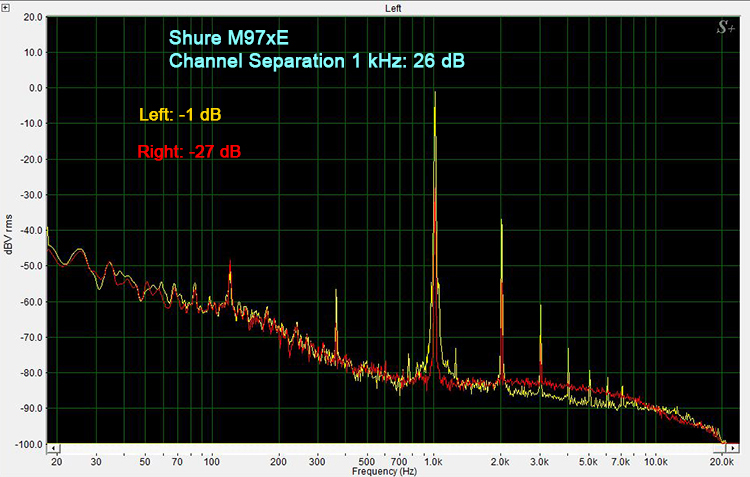
This graph shows measured channel separation at 1kHz to be 26 dB which is right on spec.
You can see the fundamental tones as well as harmonic distortion which will be discussed below. Note the rise in the noise floor below 400Hz which is the turntable rumble.
Spurs at 120Hz and 360Hz are from power line hum getting into the cartridge. Depending on the cartridges design this can change significantly. The design of the turntable also changes the amount of radiated power supply noise. The Technics / Shure combination produces well suppressed power supply harmonic spurs.
Compare the absolute noise floor of this plot with digital equipment we test. A 16bit noise floor with a 64k FFT length will be at about -120dB (SNR 98dB with 20dB FFT processing gain).
At 1 kHz the noise floor is up 40dB and it only gets worse as the frequency descends. This is noise in the vinyl and the rumble of the turntable. The noise of the RIAA preamp used is below the noise level of the vinyl and turntable.
A few claim that this pink noise floor may contribute to the LP – CD debate. The added noise is conjectured somehow to be perceived as subjectively pleasing although surface noise and ticks are obviously not.

This graph shows measured channel separation at 5kHz to be 19 dB.
Note the noise floor on the right (silent side) is lower than the modulated left channel. It is not clear why this occurs. In the 1kHz test, this was reversed indicating it may just be experiential error.
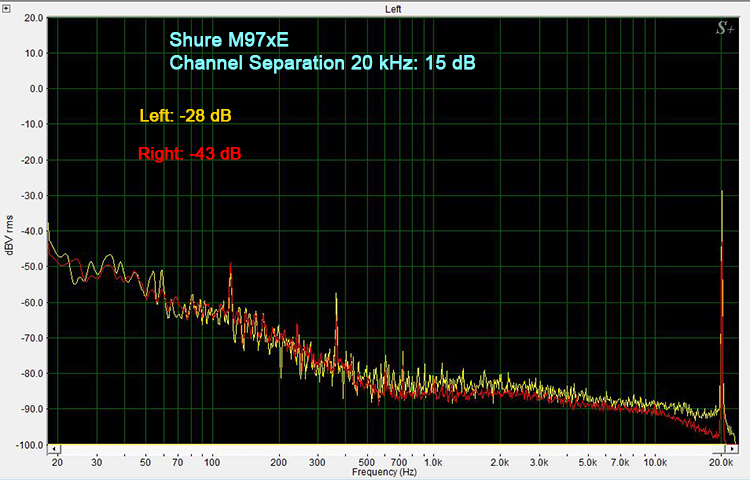
This graph shows measured channel separation at 20kHz to be 15 dB. Less expensive cartridges can produce very low channel separation numbers above 15kHz. As an absolute measurement, this is unimpressive but for a cartridge, especially at this price, it is not bad.
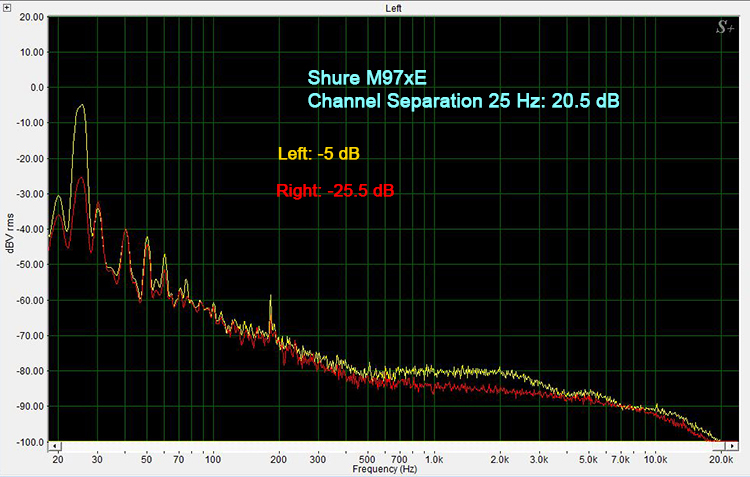
This spectrum shows the problem with making channel separation measurements at low frequencies. Note how close the red crosstalk channel is to the turntable rumble level. The turntable noise pushes the 25Hz red spur up reducing the channel separation number.
This effect is present to about 60Hz in our measurements which explains the decrease in channel separation in the graph shown above of: channel separation versus frequency.

This graph shows the effect the Dynamic Stabilizer Brush has on the lowest tonearm resonant frequencies. We decided to show the resonance excited by the turntable noise floor for this result. A tone recorded on an LP at the resonance frequency of the cartridge / arm combination will show a significant increase in amplitude but seeing low frequency tones on the spectrum analyzer is difficult.
The FFT band size is 0.4Hz for a 64k FFT at a sampling rate of 48kHz spreading the spur out. The duration of these test tones is short. Increasing the FFT size does not allow enough time for it to settle before the tone has moved to the next test level.
With the stabilizer brush up, the resonance is at 7.5Hz. The Q is calculated from the amplitude at resonance and the two frequencies -3dB down on the sides of the resonance. The higher the Q the more energy storage in the system. With the brush up, the resonance is at 7.5Hz and the Q was calculated to have a value of 4. The Q is likely higher than this and the FFT is limiting the resolution. More on Q calculation in an upcoming article, “How We Test Cartridges”, coming soon to the website.
With the brush down the amplitude of the resonance drops by 18dB. The Q has reduced to 1.4 indicating much less energy storage in the arm / stylus mechanical system.
High compliance is important for distortion performance when stylus displacements are high, especially at low tracking forces, but the trade is a low resonance frequency and high energy storage Q. The Shure brush solves this tradeoff.
When the Shure V15 III was introduced, it traded trackability for resonance frequency by increasing the compliance, and the blowback to Shure was significant. Warped records were causing all sorts of problems. I lived near some train tracks and an oncoming train could result in the cartridge skipping grooves.
Some special low mass arms were developed just to deal with this cartridge but that limited its sales. The damped brush was the solution, which first appeared on the Shure V15 IV. The original M97E was the first mid-priced cartridge solution with the Shure brush. Those with long memories will recall that Stanton / Pickering cartridges had brushes back to the 60s but they had no added damping.
The brush was a super solution and the patents are now long gone. You would think every cartridge would have a damping brush and be high compliance but no. Audiophiles thought the brush had a sound. It did since it reduced the resonance as well as reduced static charge and removed dust but they heard it as a negative.
Today with no brush and higher mass arms we are seeing low compliance cartridges. This evolution requires higher downforce.
A cartridges output is proportional to the groove velocity not the amplitude. Harmonic distortion measurements are thus, typically taken, at a constant groove velocity. In our tests, the peak velocity is 5cm / sec above 500Hz. See the upcoming, “How We Test Cartridges” for more details
The measurements were done at the Shure “Tracking force – optimum setting” of 1.25 grams.
The Shure M97xE spec sheet lists the following as the maximum velocity the cartridge can track. The THD value is not specified.
Trackability@1g peak velocity:
400 Hz 30 cm/sec
1 kHz 46 cm/sec
10kHz 30 cm/sec
In general, it appears mis-tracking is defined to be audible distortion. On single tones that is around 5%. As will be seen below these numbers appear to be optimistic especially the 10kHz number.
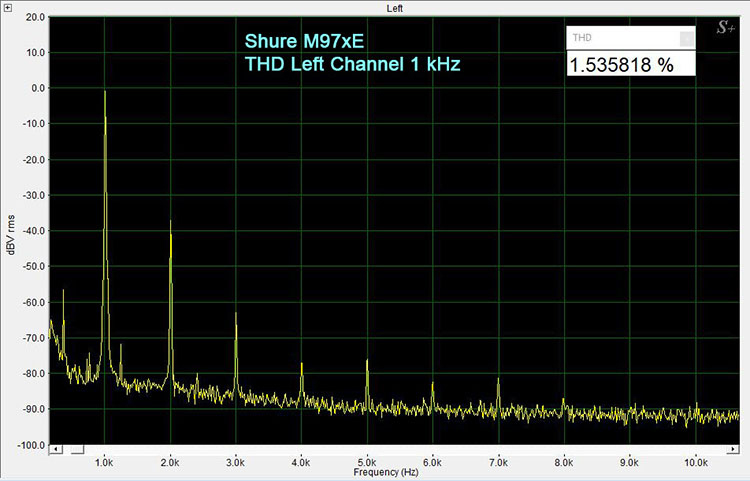
This graph shows the Shure M97xE having a THD of 1.5% at 1kHz. The best cartridges can produce distortion below 0.5% at this frequency and groove velocity (5cm / sec) in our tests.
The THD value appears high but this is lower than how other $100 cartridges perform using the UK magazine Hi Fi News and Record Review measurements as reference.
You really have to read the fine print when you compare between reviews with respect to harmonic and IM test results. Groove velocities can change in different graphs showing distortion and RIAA EQ may be in some measurements but not others. It is best to compare our test results of different cartridges if you do not want to be in the weeds.
At the time of these measurements we did not have a test LP with isolated sine waves above 5cm / sec. Distortion in cartridges does not necessary increase dramatically with increased groove velocity but the Shure specification of 30 cm / sec before audible distortion does not appear likely for this sample.
Stylus shape and tip mass play an important role in distortion tests. The Shure 0.2 x 0.7 mil stylus is thinner than others at this price range. The Shure has bonded stylus, common at this price point, which adds mass relative to nude mounting found in cartridges a little under twice this price.
Note these measurements are at 1.25 grams. You may not find another production cartridge with this recommended downforce. The mass of today’s tone arms makes high compliance designs impractical. Patent protection on the brushes is long gone but no other company has chosen to offer the solution. Instead we live with increased down force and increased distortion even at these higher down force requirements.

Here, the THD of the Shure M97xE increases to 3.7% at 5kHz. This is an order of magnitude above what the best cartridges can do at this groove velocity. The stylus shape is playing a significant role now.
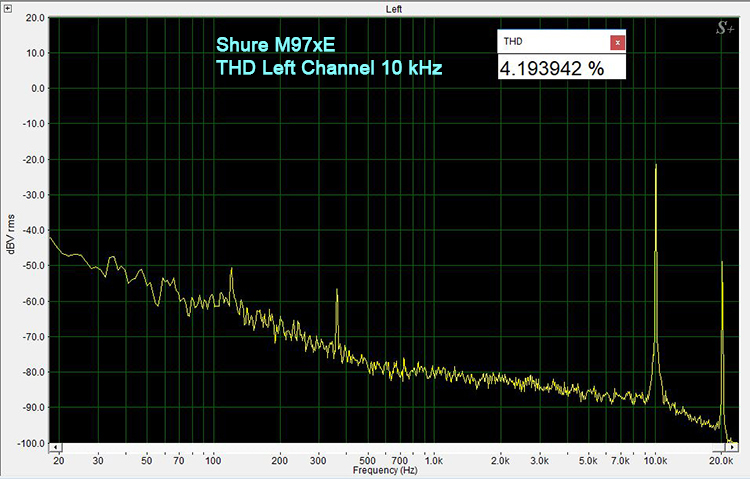
This graph shows the Shure M97xE having a 2nd harmonic distortion of 4.2% at 10kHz. You cannot talk THD with all the other harmonics out of band. The elliptical stylus is having a hard time following the groove at 5cm / sec. This would be audible mis-tracking but only with a cooperative 13-year-old with musical training to identify the octave distortion.
The 30cm / sec spec is not being achieved with this sample. It is gone at 5cm / sec. THD below 1% can be achieved. Those types of cartridges have a Micro Ridge stylus and low mass cantilevers made with materials such as beryllium or boron. The Shure V15 5MR and a long line of Audio Technica cartridges from the 80s to today had these ingredients along with high compliance. Audio Technica had no brush and the cartridges they produced had low frequency resonances with huge energy storage. You needed an external damping device added to the arm. Audio Technica has lowered the compliance in the latest cartridges which giveth and taketh away. We have some in testing now but these start at $250 and go to 3X of that.
At $100 4% at 10kHz – 5cm / sec is still better than results for other cartridges at this price point which can produce 4% distortion at a lower 2cm / sec groove velocity.
We move now to the Shure TTR117 trackability test LP. OK I hear you – this is a test of a Shure cartridge with a Shure test LP. It turns out the best results we have seen in these tests is with the Audio Technica ML150MLx (discontinued) with 30 hours use compared to the original Shure V15V-MR with about 200 hours use. The passage of time and ozone in the atmosphere can degrade the rubber parts of a cartridge. The Shure was from 1990 and the Audio Technica 2007.
The TTR 117 LP tests harmonic and intermodulation distortion. It has 3 tones at 200Hz, 2.1kHz and 17kHz.
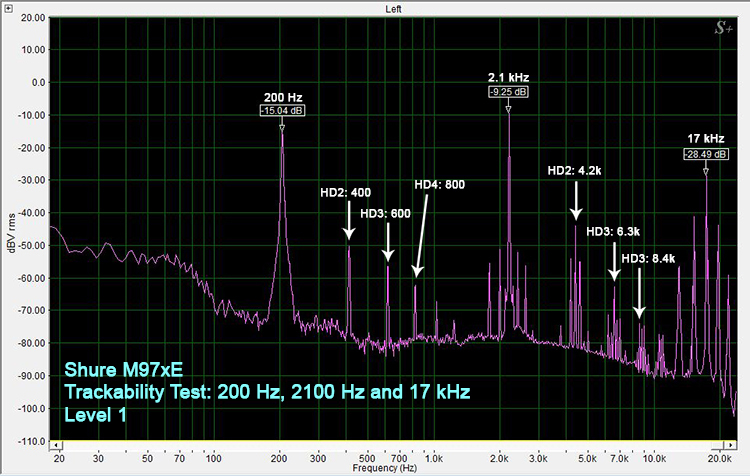
The Y axis is referenced to 0dB for a 1kHz groove modulated at 5cm/sec which is the standard recording level with RIAA EQ in the signal path.
The location of the signals and the harmonic distortion of the Level 1 test are shown above.
The graph above is normalized so 0dB represents a 5 cm / sec 1kHz tone with RIAA equalization.
Level 1 has the 200Hz tone at 0.4cm /sec (-15dB with the RIAA EQ), 2.1kHz at 1.8cm / sec (-9dB with the RIAA EQ) and 17kHz at 5cm /sec (-28dB with the RIAA EQ). The 5 cm / sec level used in the above signal for single tone distortion tests above 1kHz. We will have more on this in the upcoming, “How we Test Cartridges” article which gives details on the CBS STR 100 test LP.
The fundamental frequency spurs and the harmonics of the 200Hz and 2.1kHz tones are shown above. 17kHz harmonics are out of band.
The Level 2 test increases the groove velocity by 2dB and Level 3 is up another 2dB. Levels 4 -6 increase 1dB.
The tone frequencies and levels are said to represent a worst-case LP tracking condition at Level 6. Before spectrum analysis it was impossible to see what was going on with these tests. Shure said to listen for mis-tracking but darn it if we could hear anything. Spectral analysis shows why TTR117 is such an important test LP for modern cartridge testing.
With three tones on the test track the maximum amplitude of the groove of the composite signal is significantly higher than for any tone alone.
TTR 117 uses lateral mono tracks not the stereo tracks used for the single tone THD tests. In stereo, the stylus must move in the vertical and horizontal plain. For the right channel, the horizontal and vertical movements are in phase. For the left channel, the horizontal movements are out of phase. This is how compatible stereo was created. The mono stylus does not see the horizontal movements.
Given the groove velocities, the TTR 117 is most useful for IM testing and it is those spurs we will concentrate on. The fig-ure below shows the IM spectra of the Level 1 test.

Mixing of the 200Hz tone with the 2.1kHz tone results in sidebands at 1.9kHz and 2.3kHz. Mixing of the 400Hz harmonic of the 200Hz tone with 2.1kHz gives rise to the 1.7kHz and 2.5kHz sidebands. The same thing happens between the 2.1kHz tone and 17kHz tone with sidebands at 12.8kHz, 14.9kHz, 19.1kHz and 21.2kHz. All the fundamental tones are lateral only. More strenuous IM tests mix a vertical test tone in with a lateral.
At Level 1, IM distortion components around the 2.1kHz tone are at least -40dB down (1%) which is lower than the 4.2kHz harmonic which is at 2.2%.
Things are looking much worse around the 17kHz tone. The 14.1kHz IM spur is down -13dB from the 17kHz fundamental which is 22% and slightly lower at 19.1kHz. Combined the IM is 30%.

Skipping directly to Level 6, the tone level is up 7dB. Level 6 has the 200Hz tone at 0.9cm /sec (-8dB with the RIAA EQ), 2.1kHz at 4cm / sec (-2dB with the RIAA EQ) 17kHz at 11cm /sec (-21dB with the RIAA EQ).
We saw in Level 1 that the 17kHz tone was already mis-tracking. The 17kHz fundamental should be up 7dB at Level 6 to -21.5dB but it is only -25.5dB in this measurement. A clear sign the stylus has lost the groove. The 14.9kHz spur is at 71%. With all the IM spurs the distortion exceeds 100%.
We can still get useful data from the 200Hz and 2.1kHz tracks although the mis-tracking at 17kHz may degrade these numbers.
200Hz is now at 0.9cm /sec (-8dB with the RIAA EQ) and 2.1kHz is at 4cm / sec (-2dB with the RIAA EQ) These are still around the velocities we used for single tone testing.
The 2nd harmonic at 200Hz is 1.4% The 3rd harmonic has enough amplitude to increase the distortion to 1.7%. This would be the THD since the 4th is well down in level.
The 2nd harmonic of the 2.0kHz tone (4kHz) is at 2% The 3rd harmonic is 20dB down from this and can be ignored. The 1.9kHz and 2.3kHz IM spurs are much lower than this at 1.6% each. The pair would be at 2.2%.
Note the high-level IM spurs around the 2.1kHz harmonics at 4.2kHz, 6.3kHz and 8.4kHz Almost all the X axis has some spur from 2kHz to 12kHz but most of these are very low in level.
Summing it up, the Shure M97xE is a good performer relative to other $100 cartridges but the simple elliptical stylus significantly degrades harmonic and intermodulation distortion. At 10kHz, it is just hanging on at the standard recording level of 5 cm /sec which sounds bad but other $100 cartridges likely give up before this. The specified performance is 30 cm / sec.
On the positive side, you will not find another $100 cartridge that tracks at 1.25 grams or one with a damping brush which we showed was effective.
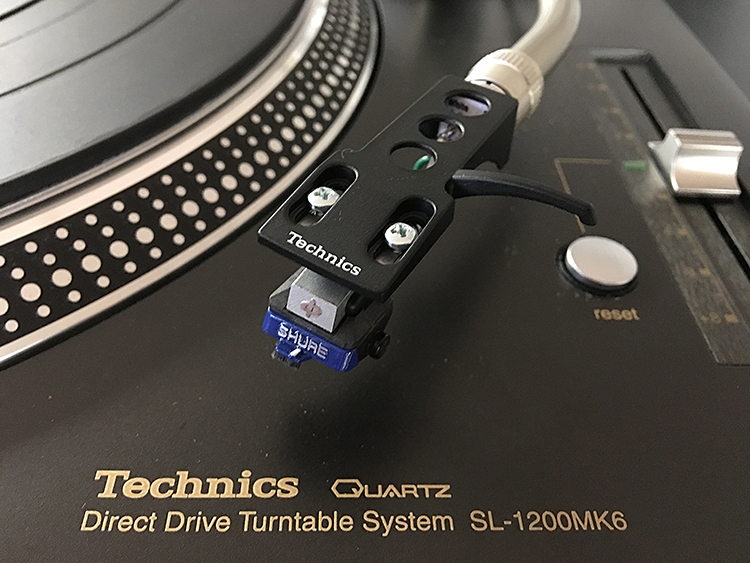
From a price-to-performance standpoint, THE SHURE M97XE is about as good a phono cartridge as you will likely find in its class.
- Warm, smooth sound quality.
- Low tracking force.
- Low distortion for a cartridge.
- Stabilizer brush is a useful tool.
- Very good trackability at any price and fantastic at this price.
- Better high frequency response. Not so rolled off.
- There is room for a higher performing model in Shure’s line. The timing may be right for it too.
The Shure M97xE is a very good mid-level phono cartridge to start breaking in, or to perhaps rediscover, your trusty vinyl collection. At $99.00, it won’t bust the bank but it will get you a warm pleasing sound in the midrange and solid bass reproduction for its efforts. Some listeners may also find the relaxed high frequency playback to be to their liking, others may not. It does, however, tend to align with Shure’s description of the M97xE in providing a “fatigue-free listening experience.” While perhaps not as revealing as some more expensive cartridges, the Shure M97xE will deliver smooth sounding vocal reproduction that is especially pleasing to the ear. The Dynamic Stabilizer Brush alone makes a significant improvement to any tonearm not employing some other type of external damping solution. I don’t think it would be too outrageous to say that this type of brush should be something that more phono cartridges should deploy.
My colleague, David Rich puts it more succinctly: “The Shure M97xE is a very good cartridge and its performance far exceeds its price in the current market. The stylus pressure and tracking performance of this cartridge will reduce record wear. The damper will improve performance on warped records. It is time to remove the $30 cartridge that came with your turntable and stomp on it. This is the minimum price you can pay for cartridge that will protect your vinyl.”
I believe it also would make an excellent building block for Shure to develop more advanced modern phono cartridge designs from. Thus perhaps, bringing a little of the old Shure magic back to be enjoyed by the vinyl players of today. The Shure M97xE is indeed a good place to start.




